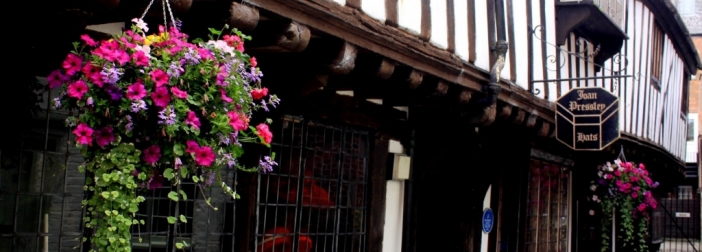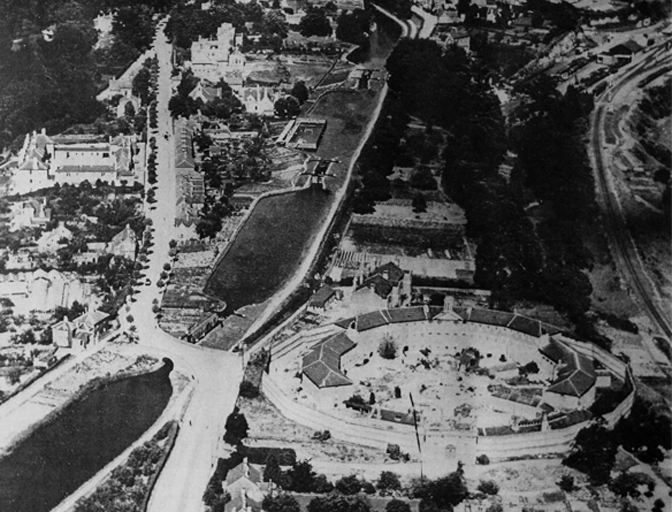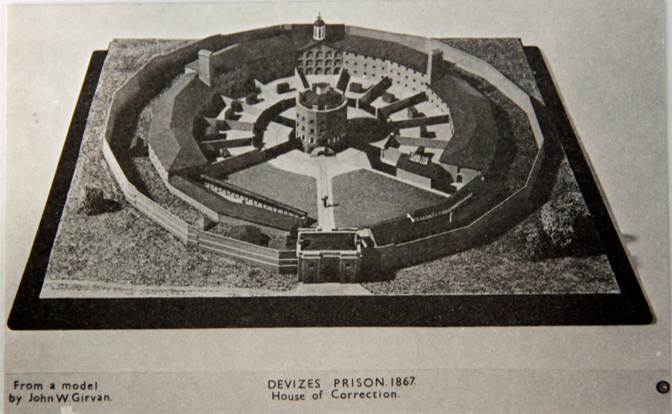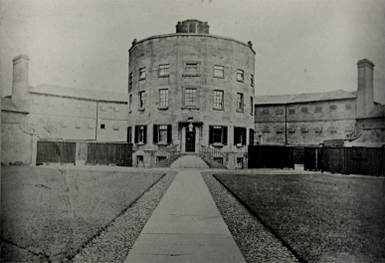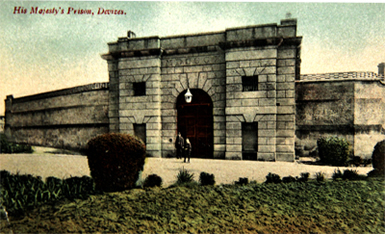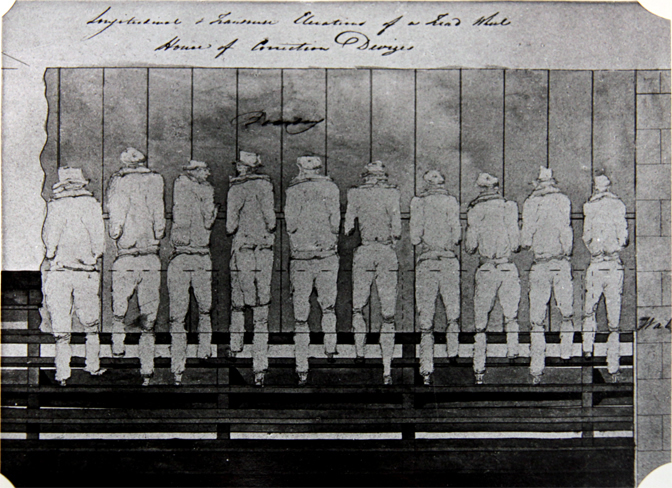Devizes Prison, the County House of Correction
The new Devizes County House of Corrections was begun in 1810 and opened in 1817. It had an operating life of over 90 years. It was closed in 1922 and demolished in 1927 by Chivers and Co. This new Prison replaced the Old Bridewell (prison) in Bridewell Street, Devizes.
The Devizes County House of Correction stood on the north side of the Castle's Old Park. It was across what is still called the Prison Bridge over the Kennet and Avon canal on the Trowbridge road out of Devizes. In the 1830s it averaged some 700 prisoners.Photogallery for the Prison
Below is a1924 aerial photo of the prison. It has closed and is being demolished by W.E. Chivers Co.; the Governor's House has gone but the polygonal shape is clear. The location is just by Prison Bridge on the kennet and Avon Canal. The railway is seen to the right, the Wiltshire Constabulary HQ on Bath road is visible (large and to the left) and St Peters School is the large and tall building top left. A larger scale version of this photo appears in Old Photos. This photo is supplied courtesy of Glynis and Terry Hillier of the Black Horse Pub.
The Prison was designed by Richard Ingleman as a two-storey polygon, of brick and stone, surrounding a central governor's house. It thus reflected the panopticon principle.The model shown below was constructed by John Girvan, author and local historian. (The photo is courtesy of the Wiltshire and Swindon History Centre)
In the attics of the house were two infirmaries. There was a chapel. Sixteen wards, each with a yard and radially arranged, were planned. Not all, however, were built; there were ten of each in 1819 and eleven, one for women, in 1836 and afterwards. The women were reckoned to be poorly housed in 1836 and in 1841–2 new cells were erected for their better accommodation. These probably formed a third storey above five bays of the polygon on the side facing the gate. At demolition there was certainly an extra storey at that point. The women were also given a separate laundry and day-room and a new infirmary at the same time. A tread-mill was authorized in 1823; it worked a corn-mill which lay outside the walls - see the photo below.
An official report on the prison is cited in "The Chronicles of Devizes" by James Waylen dated 1839. The report dated sometime earlier in the 1830s states: The
Governor's house (below right) overlooks all the yards, and the
building is very secure. There are eleven wards and eleven yards, 10
belonging to the men and one to the women. The total number of cells is
210. Dimensions of single cells are 10 feet high, 7ft. 5 inches wide,
and 8ft. 5 inches long. That of the women's 7ft. high, 5ft.
The diet consists of 2 pounds of wheaten bread and one pint of gruel made of oatmeal and potatoes. On Wednesdays and Fridays, in lieu there of vegetable soup. Those on the wheel (treadmill presumably) are allowed an extra biscuit. This wheel grinds corn for the Prison and the public. There is also a crank for raising water. Other occupations are white washing, baking, cooking, and cleaning. The hours of labour are in summer 9 hours and during the rest of the year never less than 6 hours. The profits of the labour are about £30 which is appropriated to the County.
Some time ago, the Chaplain applied to the magistrates to give permission that certain ladies in the neighbour hood might act as teachers to the females, but this was declined. The women rarely ask to see the Chaplain, but when they are ill, he visits them of his own accord. He himself is friendly to short imprisonment with confinement to the cell, without work, for 20 days.
The Surgeon Charles Trinder pays regular visits twice a week. A table which he has drawn up, proves by the comparative weight of the prisoners on admission and dismission, the favourable effects of the discipline and diet on their health. Out of 500 weighed from the 25 March, 1835, to 25 March, 1836, there were hardly a dozen who had not gained in flesh.
The officers of the prison and their salaries for 1847/8 are shown in this LINK. Dr Charles Trinder was the Prison Surgeon from at least 1822 to 1850. He lived in Brownston House in Devizes; some of his life story is shown under the history of that house.
Below is a photo of a drawing of convicts grinding corn on the Devizes Prison treadmill in the late 19th century. (Both photos courtesy Wiltshire and Swindon History Centre).
Hangings at the Devizes prison Historically hanging in Devizes took place at the Gallows ditch on Highworth Road from the 12th century onwards. This site now has a small green area on the castle side of the road and opposite the beginning of Hartmoor Road. In the early 19th century burglary, attempted murder and murder were all capital offences for which the death penalty was the sentence. There were gallows at the prison and in 19th Century there had been public hangings. People used to come from miles around, even on a trip on the canal - to witness them. The gallows were situated high up on a tower on the outside of the prison so that people could have a good view of the spectacle The first execution at Devizes was in 1824. Two men, John Goodman and Edward Amor were convicted of robbery and hung on the 20th April, 1824 outside Devizes Prison. Edward Amor of Pewsey and John Goodman of All Cannings were sentenced to death having been convicted of theft and "violent assault" against Thomas Alexander of South Farm, All Cannings on 24 December 1823. Both men worked as sawyers for Clark & Robbins at Honeystreet Wharf near Pewsey. The Sunday prior to their execution they attended a service in the prison chapel with their coffins and shrouds placed before them to kneel on. They were executed on Tuesday 20 April 1824, with Goodman pleading his innocence to the last.
George Maslen of Lyneham, Wiltshire was a notorious poacher and had been imprisoned for 12 months. Two convicts said Maslen had confessed to them that he shot a farmer, intending only to scare his horse and rob him. He was then charged with the then capital crime of attempted murder. He was hung outside Devizes Prison on September 6th 1838 in front of a reputed crowd of 20,000. The prison Bridge gave a good view.
Rebecca Smith of Bratton near Westbury, Wiltshire was hung on 23rd August 1849 outside Devizes prison. She had been married for 28 years to an abusive drunkard. She had given birth to 11 children. All but the first one were dead. The second child died of natural causes and she killed the next seven, one of them with arsenic. She was the last woman to be executed for infanticide.
Serafin Manzano was hung on April 11th, 1860. He was Spaniard looking for work and begging around Tollard Royal Wiltshire. He murdered and mutilated Mrs. Anastasia Trowbridge. The house had been burgled and when found he was wearing the clothes of his victim's husband, Then executioner was William Calcraft.
Charles Gerrish aged 70 of Devizes was hung on January 30th 1882. He was a resident of the Devizes Workhouse. Huddled over a fire in the workhouse in Devizes he wanted more warmth from the shared fire and after an argument Gerrish pulled a red-hot poker from the fire and thrust it into Coleman's neck, killing him instantly.
John Gurd of Devizes was hung on July 26th ,1892. he is reputed to have killed his prospective Uncle whom he thought had dissuaded his fiancee from marrying him. Gurd shot Henry Richards as they strolled along he canal bank in Melksham. On his arrest he shot and killed a policeman Sergeant Enos Molden aged 49 who died shortly afterwards in hospital. Gurd was finally captured and despite pleading insanity, was hanged for the two murders.
The last hanging took place on 1903; the executioner was Henry Pierrepoint.
Some newspaper accounts of prison sentences involving Devizes and the Old Bridewell from the Salisbury Journal. The sentence is to the House of Correction unless stated.
1827. Case of Catherine Cooke. His Majesty has been pleased to remit that part of the sentence passed on Catherine Cooke at the last Marlborough sessions (for stealing china from her master, Ernle Warriner, Esq. of Conock House), so far as relates to solitary confinement and hard labour. The sentence of the Court was that she should be imprisoned in the House of Correction at Devizes for two years: the first six months, and last six months, to be in solitary confinement.
1827. Committed to the House of Correction, Devizes; William Bear of Calne, James Bayley, of Edington, Joseph Mould of Fonthill Gifford, John Barber of Horningsham, George Miles and James Snook - both of Maiden Bradley, James Mortimer and William White - both of Trowbridge, George Drew of Box, Thomas Haskill of Pitton, and Isaac Locke of Clarindon, for three months each for breeches of the game laws.
1827. Thomas Keen and John Weaver for one month each, for leaving their families chargeable to the parish of Ashton Keynes, Joseph Barter for three months for leaving his family chargeable to the parish of Broad Chalke.
1827. Committed to the Old Bridewell, Devizes - Solomon Blackford, William Turner, William Sollis and Henry Pithouse on charges of poaching.
1841 During the Chartist riots). William Carrier married with 1 child. "Does not intend to live with his wife again as he believes her to have been unfaithful to him." Religious persuasion: does not afford a distinct account but has latterly attended the Democratic Chapel at Trowbridge. He has been in various occupations. Offence: "Assembling at and addressing unlawful and seditious meetings to excite to hatred of the Government and Constitution and in contempt of the laws." Sentence: Two years hard labour. County House of Corrections, Devizes A schoolroom existed by 1842. Further alterations, including the addition of ten cells and the enlargement of the chapel, were authorized in 1867.
In 1868 when Fisherton Anger gaol was closed, Devizes became the only county prison, and, as such, was transferred to the state in 1877.
Between 1912 and 1914 it was used only for prisoners on remand. It was a military detention barracks from 1914 until 1920, when it fell completely out of use, and then or in 1921 it was closed. In 1922 it was bought as a building site and by 1927 it was compltely demolished.
|

